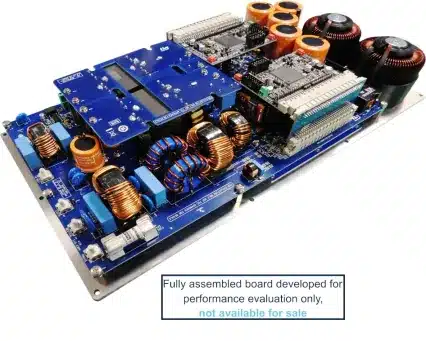The on-board charger reference design of electric vehicles offers high power efficiency, innovative heat management, and modular adaptability.

An on-board charger (OBC) is an integral component of electric vehicles (EVs) responsible for converting the alternating current (AC) from the electric grid into direct current (DC) to charge the vehicle’s battery. As the name implies, this charger is typically installed within the vehicle itself. With the burgeoning growth of the EV industry, the need for OBCs has become paramount. They enable EV owners to charge their vehicles conveniently at home, workplaces, or public charging stations. The STDES-7KWOBC from STMicroelectronics is a reference design for an OBC that facilitates the charging of EV batteries. This charger lets users power their EVs using a household AC mains plug or private and public AC charging stations.
The design is divided into two main segments. The first segment comprises an interleaved totem pole Power Factor Correction (PFC) stage that employs a 2-channel interleaved totem pole topology, operating at a frequency of 70 kHz. The second segment encompasses a dual galvanically-isolated full bridge Load-Inductor Load-Capacitor (LLC) Direct Current to Direct Current (DC-DC) Zero Voltage Switching (ZVS) resonant converter with a resonant frequency set at 140 kHz. This converter utilises MDmesh DM6 super-junction power Metal Oxide Semiconductor Field-Effect Transistors (MOSFETs). The power framework of this reference design is impressive. It has a 7 kW unit capable of consistently delivering a current or voltage output. Furthermore, it boasts the versatility of operating individually (1 PH+ N), in conjunction with other units, or a 3-phase mode (3Ph + N), potentially increasing its output to a substantial 21 kW.
One of the notable features of the OBC design is its heat management system. An insulated metal substrate (IMS) is strategically placed on an aluminium base plate, ensuring optimal heat dissipation. The incorporation of either forced air or liquid cooling mechanisms further enhances this. Every module within the reference design facilitates straightforward interlinking with other identical modules via wires or bus bar connections, enabling an amplified output power. The standout feature of this reference design lies in its efficiency and high power density. This is achieved through the incorporation of Silicon Carbide (SiC) and super-junction (SJ) power MOSFETs, silicon and SiC diodes, gate drivers, the SPC58NN84E7RMHBR automotive-grade microcontroller for power architecture, and Silicon-Controlled Rectifier (SCR) thyristors, which limit inrush current. Notably, a 12 V input supply voltage is galvanically isolated from the output voltage ground, which connects to the high-voltage battery. This design also supports both constant current and constant voltage modes.
STMicroelectronics has tested this reference design. It comes with a Bill of Materials (BOM), schematics, etc. You can find additional data about the reference design on the company’s website. To read more about this reference design, click here.





